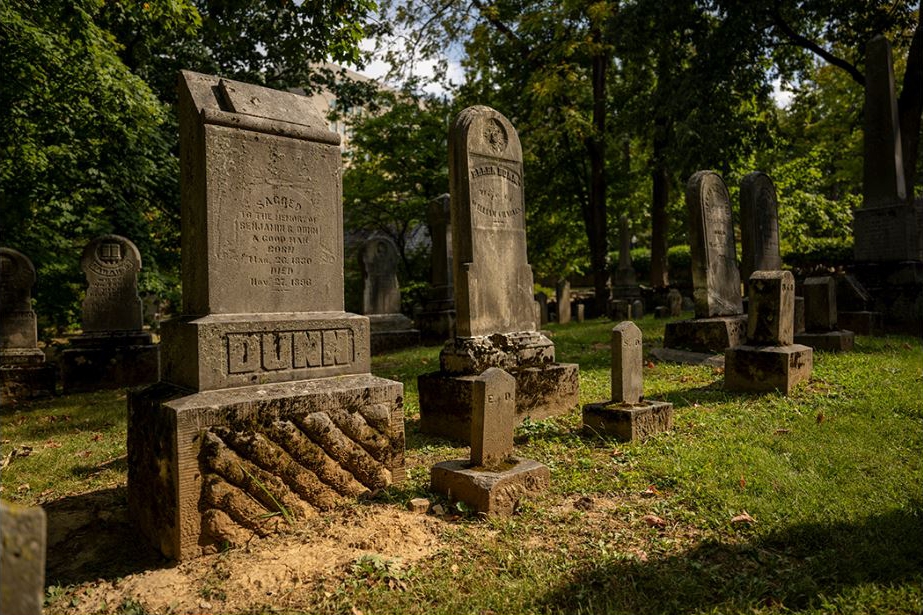The Dunn Cemetery–Indiana University

NOTE: The following article was originally published in the Fall 2023 edition of the Indiana University Alumni Magazine. Aerlex Law Group founder and President Stephen Hofer is an Indiana alumnus and thought our Aerlex audience might find it of interest, even though it’s definitely “off-topic,” at least as far as business aviation is concerned. This is the first in a four-part series. Stick with it through all four parts – we think you will ultimately be at least a little entertained and charmed by what you’ll learn about the Indiana University campus, a pioneer graveyard, Revolutionary War patriots and the founder of our firm.
By Deborah Galyan
THERE’S something slightly uncanny about a cemetery reposed in the heart of a busy campus
like IU Bloomington. The paths between Ballantine Hall. the Chemistry Building. and Woodburn Hall are teeming with students who check their phones and chatter with friends as they trek to their next classes. They bring the campus to life each year with fresh energy and new dreams. The concept of `eternal rest” is surely far from their minds. Yet. just a few steps away lies a cemetery in a shady knoll between the Indiana Memorial Union and Beck Chapel.
Dunn Cemetery is a peaceful spot with an air of a quiet dignity, keeping with its original purpose: Provide a private place of eternal rest for members of the Dunn and Brewster families who first settled in Bloomington. The site was designed in the shape of a kite, some have said, in the hope that it might help lift the beloved souls of the departed to heaven.
Two hundred years have passed since Samuel Fowler Dunn Jr. and Elizabeth (Grundy) Dunn migrated from Kentucky to Bloomington and purchased a large parcel of farmland in the 1820s. They raised eight children in a house they built near the School of Public Health (the former HPER building), and their cows once grazed in a pasture where the Garrett Fieldhouse stands today. Samuel’s widowed mother. Ellenor (Brewster) Dunn, also moved north to be near the couple. Several generations Lived on or near the farm until 1883, when IU trustees purchased 20 acres for the construction of a new campus. Today, the cemetery is the most obvious remnant of the homestead, but one can also imagine its old pastoral beauty in the soothing green spaces of Dunn’s Woods and Dunn Meadow.

Velvety moss clings to the native limestone fence surrounding the cemetery. Maples, black walnut, pin oak, and other native hardwoods stand guard over the grounds. Inside the ironwork gate, weathered gravestones stand at odd angles. Approximately 68 people are buried in the cemetery, possibly a few more in unmarked graves. A dozen or so were born in the 1700s—several before the American Revolution. An unsettling number of infants and children rest alongside their parents. Some inscriptions are lost to time, washed smooth by centuries of rain and wind. The newest gravestones record death years of 2016 and 2019, indicating that the cemetery is still an active burial site.
As cemeteries go, it’s not very spooky. There is little if any ghost lore associated with the spot, beyond occasional sightings of a “lady in black.” But it’s still a popular stop on the annual ghost walk, organized by Folklore and Ethnomusicology students and faculty around Halloween.
Beneath the bluff on which the cemetery sits is the Union’s parking lot. Until 1950, that area was home to Jordan Field—used until 1924 for IU football games and until 1950 for IU baseball games. In winter months, the field was transformed into an ice-skating rink. One story claims that a game was once stopped to accommodate a funeral being held at the cemetery. Once the funeral ended, the game resumed.
Vincent Price. the mid-20th-century master of horror cinema, is said to have opened a lecture he gave at IU Bloomington in the 1980s by sharing how much he had enjoyed waking up in the Indiana Memorial Union that morning to the view of a graveyard beneath his hotel window.
NOTE: This is the end of Part One.
